Tests Over HDMI With R&S UPP Audio Analyzers
Author: Klaus Schiffner (product manager for audio analyzers at Rohde & Schwarz)
Photos: Archive Rohde & Schwarz
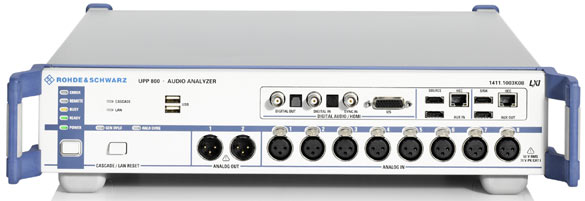
HDMI is a firmly established standard interface in consumer electronics. The interface allows audio and video signals as well as InfoFrames to be carried on a single cable. A new option for the R&S UPP family of audio analyzers from Rohde & Schwarz enables audio to be tested on hi-fi equipment and components over HDMI. The analyzers generate the required test signals and provide a variety of options for signal analysis. They can even test the video functionality.
Digital audio connections are gradually displacing the established analog solutions. First, the AES/EBU interface was adopted in the professional sector while the Sony/Philips digital interface (S/PDIF) was used in the consumer sector. Today, the high-definition multimedia interface (HDMI) is the standard for transmitting multimedia data in the consumer sector. All advanced TVs, DVD players, AV receivers and even game consoles connect with one another via HDMI cables: Digital multichannel audio and high-definition TV signals with surround sound are carried over the same cable.
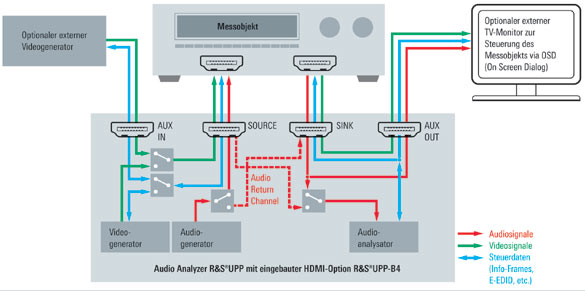
T&M equipment is now expected to support this type of interface as a matter of course. Rohde & Schwarz offers an HDMI option, the R&S UPP-B4, for its R&S UPP audio analyzer family. This enables users to conduct comprehensive audio measurements during the development, testing and production of chips and consumer electronics equipped with HDMI, including game consoles, Blu-ray players, AV receivers and TV monitors. Fitted with the new option, the analyzers feature a full array of ports needed to conduct state-of-the-art audio analysis: HDMI ports on the front, plus up to eight XLR inputs for analog channels, and digital audio interfaces in S/PDIF format with BNC and TOSLINK connectors. A digital I²S interface with up to eight channels in the transmit and receive directions for testing audio ICs is also provided.
Users today need to be able to perform measurements using any combination of interfaces, and this is what Rohde & Schwarz instruments offer: For instance, the R&S UPP can feed I²S signals to a chip and then analyze the results at its HDMI output. The R&S UPP can also apply HDMI test signals to the input of an AV receiver and test the audio quality on the receiver's analog loudspeaker outputs. R&S UPP audio analyzers can even be used to test TV monitors: The analyzers generate test signals in HDMI format and send them to a connected monitor. They can also can be used to verify correct channel assignment and to carry out a basic visual assessment of video quality, for example.
Physical HDMI data channels
In HDMI, data is transmitted between a source and a sink. A Blu-ray player, for instance, is a source; a TV monitor is a sink. In an HDMI cable, audio and video data and InfoFrames are transmitted between the source and the sink on transition minimized differential signaling (TDMS) lines.
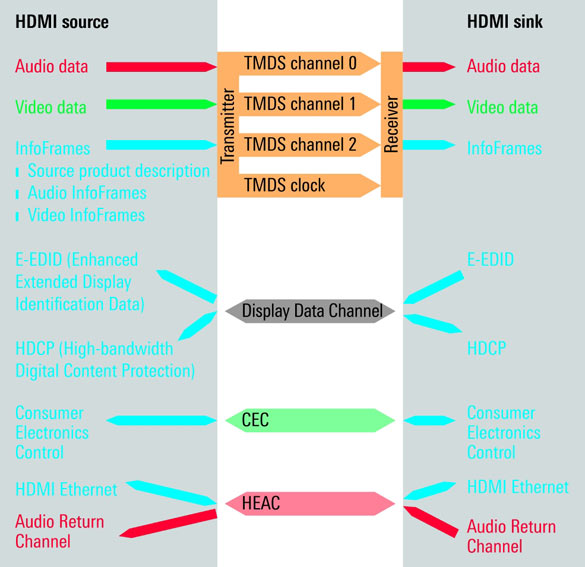
On a separate line in the display data channel (DDC), HDMI devices exchange encryption information and information to facilitate interconnection. The consumer electronics control (CEC) data bus carries data in both directions for the remote control of all connected HDMI devices. And the HEAC line transmits HDMI Ethernet data and the audio return channel.
Audio measurements
HDMI differentiates between a two-channel and an eight-channel data structure. With the eight-channel data structure, up to eight digital audio signals (surround sound channels) are transmitted as linear PCM data with up to 24 bit word length and up to 192 kHz sampling rate. HDMI can transmit compressed data streams, including streams compressed using Dolby methods.
To test eight-channel transmissions quickly and efficiently, users need a test instrument such as the R&S UPP800, which provides eight parallel channels. This analyzer can generate up to eight separate test signals in HDMI or I²S format at the same time, or can measure up to eight input signals in parallel – HDMI, I²S or analog. Unlike other HDMI test instruments, the R&S UPP800 offers comprehensive audio analysis capabilities: Besides sine signals, the analyzer can generate multitone signals for intermodulation measurements as well as burst and noise signals. Plus, its plays back voice and music signals, Dolby Digital® and Dolby Digital Plus® encoded signals and decodes them to conduct realtime measurements.
An HDMI tester needs to support basic measurements of level, frequency response, crosstalk, SNR, THD+N and phase. The R&S UPP not only provides these functions, it also supports modulation factor analyses and measurements of difference-frequency distortion (DFD), DC voltage and group delay. It also offers powerful fast Fourier transform (FFT) analysis and the ability to display the trace in the time domain, which are important for the majority of users. Thus, R&S UPP analyzers cover a comprehensive range of key audio analysis capabilities.
Video measurements
HDMI transmits audio and video data in a common frame structure. The interface is suitable for all common video formats, up to the highest resolutions. To be able to test a DUT with a full HDMI data stream, an HDMI test instrument also needs to be able to generate and analyze video data. The R&S UPP, for example, can optionally output multicolor and moving test patterns in configurable colors and color depths in addition to monochrome test patterns.
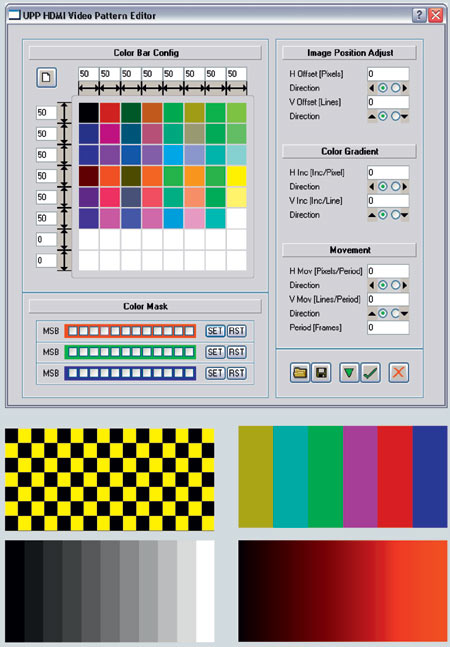
The patterns conform to the CEA-861-E video standard and have a maximum resolution of 1920 x 1080 pixel. If users require more complex video signals for test purposes, test patterns and video sequences can be fed in from an external source over another HDMI port on the instrument. The audio analyzer combines the picture data with the audio test signals it generates internally and transfers them to the DUT in a single HDMI data stream.
The analyzer section of the audio analyzer receives all HDMI data and analyzes the audio content. The video content can be passed over a separate HDMI connection to an external monitor for visual analysis. Besides pure audio analysis, an R&S UPP can optionally conduct a number of basic video measurements. For example, the analyzer can measure the pixel clock, HSync and VSync frequencies, display the timing parameters, and determine the bit error rate over an HDMI transmission. Its lip sync function measures the time offset between video and audio signals.
InfoFrames
A variety of InfoFrames are also transmitted over HDMI. The source product description InfoFrame, for instance, contains general information on an HDMI source, and the auxiliary video InfoFrame provides an HDMI sink with a range of information, including the video format being transmitted, the color depth and color range.
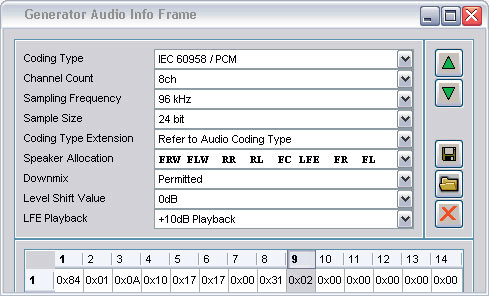
An HDMI tester needs to be able to generate all this data to match the HDMI test signals to be output. With the R&S UPP, users can edit the InfoFrame data and deliberately send incorrect data to the DUT in order to determine whether the DUT identifies errors properly and makes the corrections required by the HDMI specification.
Other data channels
The enhanced extended display identification data (E-EDID) packet and the key information for high-bandwidth digital content protection (HDCP) data encryption are transmitted on the display data channel (DDC). An analyzer should be capable of automatically decrypting the HDMI signal to conduct measurements.
The E-EDID packet provides an HDMI source with information on the video and audio formats supported by a connected HDMI sink. The generator in the R&S UPP reads the DUT's E-EDID information and can set the test signals in the suitable format. Conversely, the analyzer provides the DUT with its E-EDID information. If required, users can alter the audio analyzer's E-EDID information in order to test how the DUT will respond. The analysis functions are so comprehensive that in many cases test engineers have no need for a specialized HDMI protocol tester.
The audio return channel (ARC) allows audio signals to be transmitted from a TV to an AV receiver – to output audio through the loudspeakers in a multimedia system, for instance. The R&S UPP can generate and measure audio data on the ARC for test purposes.
The HDMI Ethernet channel (HEC) enables HDMI devices to access content on the Internet. The R&S UPP audio analyzer has two RJ-45 ports for testing Ethernet functionality.
The R&S UPP audio analyzer with the HDMI option offers the full range of functions that manufacturers of consumer electronics require in order to perform audio tests. The analyzer can even test video functionality. Users often have no need for additional T&M equipment, such as an HDMI protocol tester. All key tests can be conducted using a single instrument. This reduces both space requirements and costs. No other solution on the market can accomplish this.